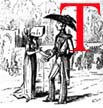Call for contributions
 he Société Française d'Etudes Victoriennes et Edouardiennes invites contributions
for issue number 66 (October 2007) of its journal Les Cahiers Victoriens et Edouardiens devoted to
Victorian Representations of War. A small CV and an abstract should be sent for approval before the deadline for the
submission of the article which is 30th December 2006. Papers are to be in English only. All submissions should conform to the notes
for contributors, and should be sent by email to Gilles Teulié, special editor of this issue : Teulie7@club-internet.fr and teulie@up.univ-aix.fr.
he Société Française d'Etudes Victoriennes et Edouardiennes invites contributions
for issue number 66 (October 2007) of its journal Les Cahiers Victoriens et Edouardiens devoted to
Victorian Representations of War. A small CV and an abstract should be sent for approval before the deadline for the
submission of the article which is 30th December 2006. Papers are to be in English only. All submissions should conform to the notes
for contributors, and should be sent by email to Gilles Teulié, special editor of this issue : Teulie7@club-internet.fr and teulie@up.univ-aix.fr.
Victorian Representations of War
Throughout the nineteenth century, Nation and State were exalted in Europe. Both notions were at the core of Fichte's or Hegel's thought. As a consequence, war was magnified for people imagined it enabled the individual to fulfil his human nature. During Queen Victoria's reign, Britain underwent a substantial series of campaigns which allowed its regiments to set foot on nearly all the continents. Whether Britain was confronted to European types of war as in Crimea, to the alliance of Western armies against native troops (The Boxer Rebellion), to colonial conflicts (known as Victoria's little wars), to the clashes with fellow colonial nations (France at Fashoda) or to the trauma of a rebellions (the Sepoys), seldom had a decade gone by without its share of reports of glorious, or not so glorious, deeds being performed somewhere in the world by Victoria's Tommies. British people had access to the representations of these conflicts through a variety of sources: the press, juvenile literature, paintings, postcards, posters, illustrated magazines, collectables, the cinema, the music hall, toys and of course literature (prose and poetry) etc. Assessing the period as a whole, one cannot but notice that increasing emphasis was placed upon the stock of the heroic British soldier (Kipling's Absent Minded Beggar). But the staging of war by Victorian artists and writers may also be understood as depicting the conflicts which took place on British soil in previous centuries (or were to take place in the future), reminding the public of the troublesome years their country had gone through or was about to confront.
Paul Fussel points out that the representations of yet another war in which British troops were involved reveal more about those who describe it than they provide trustworthy accounts of what happened:
Indeed a striking phenomenon of the last twenty-five years is the obsession with the images and myths of the Great War among novelists and poets too young to have experienced it directly. They have worked it up by purely literary means, means which necessarily transform the war into a "subject" and simplify its motifs into myths and figures expressive of the modern existential predicament. These writers provide for the "post-modern" sensibility a telling example of the way the present influences the past. [The Great War in Modern Memory, Oxford University Press, 1975, p. 321)]
Can the same light be shed on Victorian authors? Were all the artists attuned or were there significant divergences? How were all these martial events supplemented to the public? What was the aim of the artists and writers when choosing war as the main feature, or as the background, to their work? What does it reveal about "the Victorian frame of mind," as Walter E. Houghton once phrased it? Can a pattern be drawn within any degree of precision as far as mental representations are concerned? Where does the native hero of the "Gunga Din" type stand in the process? What happened between Tennyson's "The Charge of the Light Brigade" (text, 1854) and Kipling's "The Last of the Light Brigade" (1891) in terms of social representations? Was there any evolution in the way these conflicts were staged throughout Queen Victoria's reign? Were all classes of British society as well as all parts of Great Britain and the Empire equally receptive to these martial images?
The cardinal objective of this issue of the Cahiers Victoriens et Edouardiens is to examine these questions and others; it is to go beyond the mere hagiography of Victorian heroes; to delineate the principle characteristics of the production of these representations, to analyse the expedients which were employed by artists and authors, and to define the concept(s) of war in Victorian ideology.
Notes for contributors
Length of articles submitted for consideration: 30 to 40,000 characters (6000 to 7000 words). Two hard copies of the article should be sent along with the e-mail copy to Gilles Teulié. M.L.A. Style Sheet Specifications; Rich Text Format (RTF). Use footnotes, not endnotes. Illustrations are welcome but the author is responsible for obtaining all necessary copyright permissions before publication. The bibliography should come at the end of the article. For more details and to send your submission please contact: Teulie7@club-internet.fr and teulie@up.univ-aix.fr, Dr. Gilles Teulié, Special editor of the CVE, UFR LAG-LEA, Université de Provence, 29 av R. Schuman, 13621 Aix-en-Provence, Cedex 1, FRANCE.
Last modified 9 March 2006